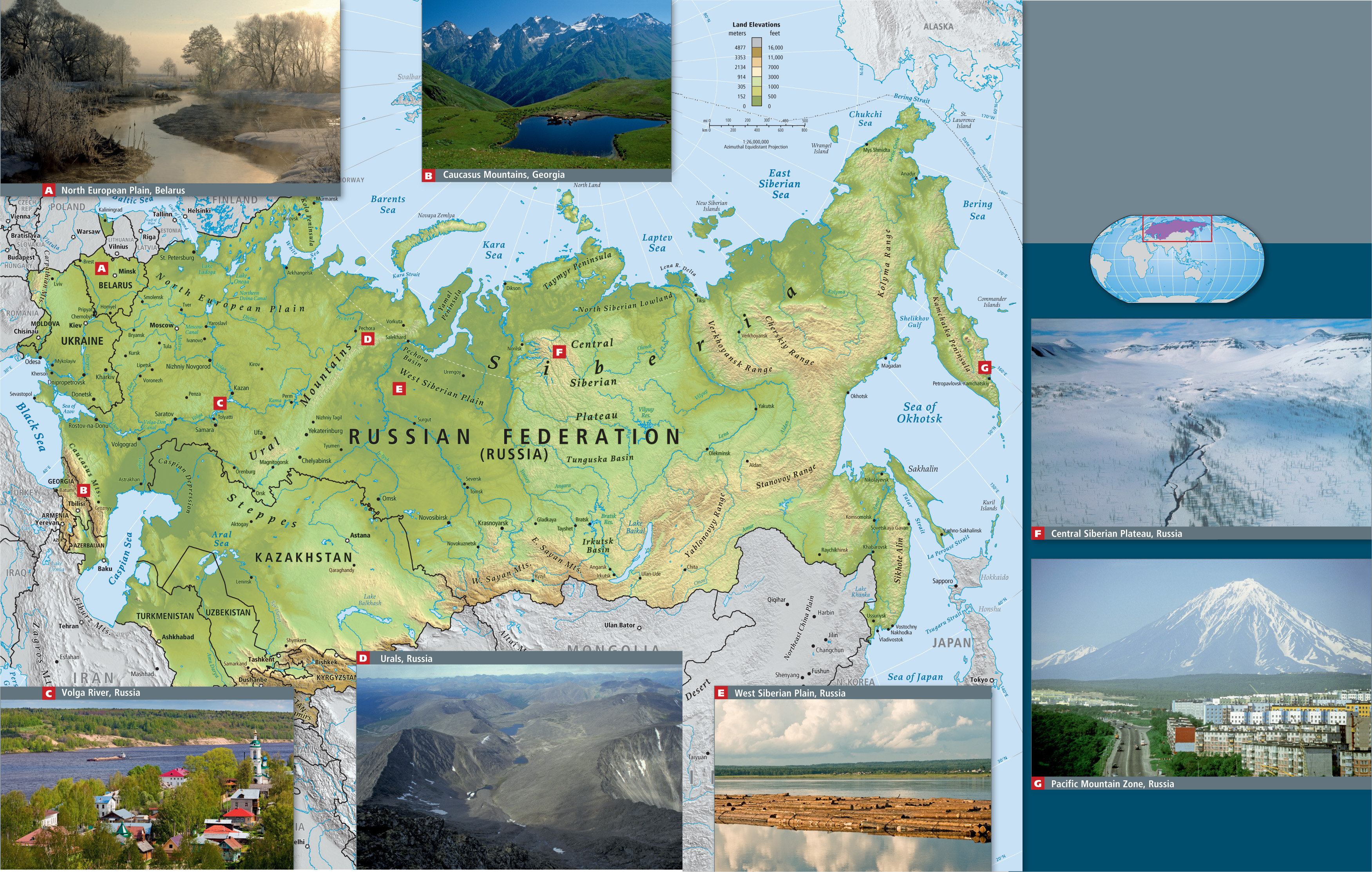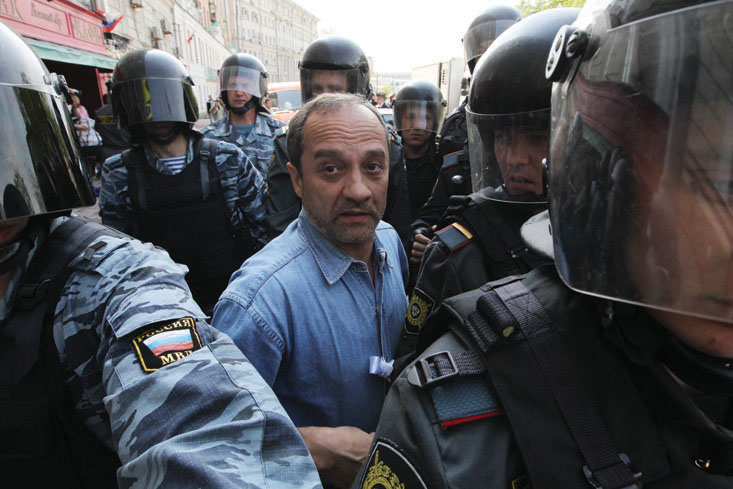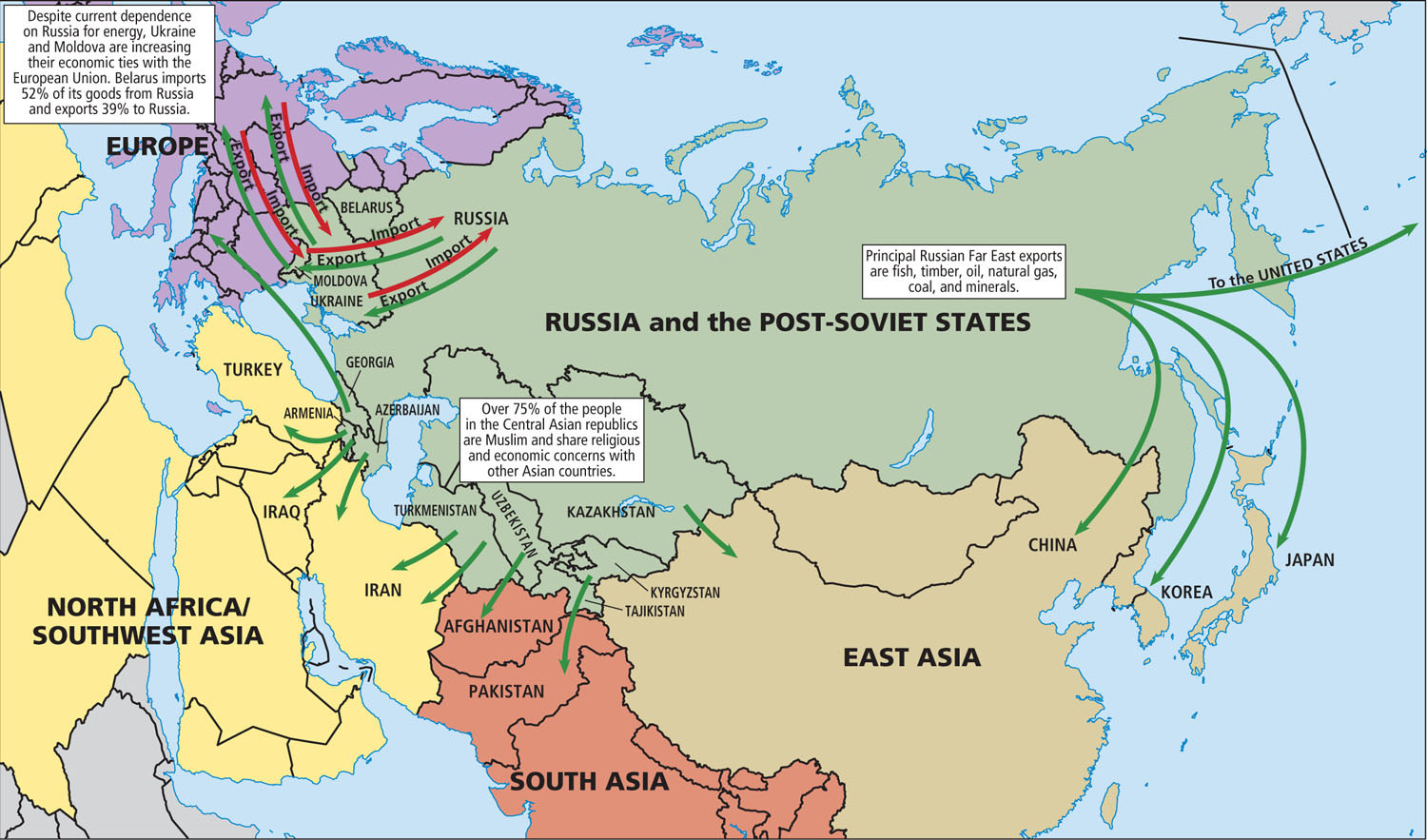5.1 5 Russia and the Post-Soviet States

246
247
248
5.1.1 Geographic Insights: Russia and the Post-Soviet States
Geographic Insights: Russia and the Post-Soviet States
After you read this chapter, you will be able to discuss the following geographic insights as they relate to the nine thematic concepts:
1. Environment, Development, and Urbanization: Development and urbanization in this region have long taken precedence over environmental concerns. The region has severe environmental problems, especially in urban areas.
2. Climate Change, Food, and Water: Food production systems and water resources are particularly threatened by climate change in parts of this region, yet the region remains the third-largest global producer of greenhouse gases.
3. Globalization and Development: Since the fall of the Soviet Union, economic reforms and globalization have changed patterns of development in this region. Many Communist-era industries closed, and as jobs were lost and public assets sold to wealthy oligarchs, wealth disparity increased. The region is now dependent on its role as a leading global exporter of energy resources.
4. Power and Politics: Obstacles to democratization include a long history of authoritarian regimes and the popular desire to implement change rapidly, combined with the lack of mechanisms for public participation in the political process.
5. Population: Populations are shrinking in many parts of this region. This is a function of a continuously high level of participation by women in the workforce and overall poor living and housing standards.
6. Gender: Men and women have been differently affected by the massive economic and political changes in this region during the twentieth century. Women have slowly gained in economic power, while, on average, men have been adversely affected by economic instability, loss of jobs, and alcoholism.
The Russian and Post-Soviet States Region
Russia and the post-Soviet states (see Figure 5.1) make up a large portion of Eurasia, the world’s largest continent. Despite its vastness, the region is not highly populated and has a climate that in many places is unforgiving. The nine thematic concepts are explored as they arise in the discussion of regional issues, with interactions between two or more themes featured, as in the geographic insights above. Vignettes illustrate one or more of the themes as they are experienced in individual lives.
GLOBAL PATTERNS, LOCAL LIVES
It’s a cold, snowy day in Moscow, the capital of the Russian Federation, in February 2012. Tens of thousands of protesters hold hands to form an enormous circle around the city, along one of the traffic-clogged ring roads that the capital is known for. National elections are coming up soon, and the demonstrators are trying to defeat the favorite for the presidential post, Vladimir Putin. Marina Segupova, a 28-year-old interior decorator, participates in the demonstration, which she hopes will spur further protest. Using a metaphor apt for the moment, she describes the protest movement: “We are a snowball and we are rolling.” At the same time she acknowledges that change will not come easily. Another middle-class professional, the 56-year-old accountant Galina Venediktova, came to voice her opinion about corruption and poor public services. During that same month, other forms of protest were less conventional. The feminist punk band Pussy Riot staged an unauthorized “guerilla performance” at a Moscow cathedral, in which they decried the policies of Vladimir Putin and became a worldwide media sensation.
Putin had already served 8 years as president, from 2000 to 2008. Prevented by the constitution from running again, he had an ally become president for 4 years, after which Putin staged a “comeback” that passed constitutional muster. Despite the efforts of Segupova, Venediktova, Pussy Riot, and other demonstrators, Putin is again serving as president of Russia after having decisively won the March 2012 election. The outcome of the election was hardly in doubt, due to the lack of other serious contenders for the presidency and Putin’s dominance in state media reporting.
On the face of it, these events suggest that the political status quo has been maintained and that power is still concentrated within a small group of politically elite people who have a questionable commitment to democracy. However, the outburst of demonstrations indicates that the political landscape is slowly changing in Russia. A few months earlier, a contested election to Russia’s parliament, the Duma, also resulted in widespread protests, as many felt that the victory of Putin’s party was questionable. After Putin’s election, protests continued in the streets and squares of central Moscow (Figure 5.2). In 2012, three members of Pussy Riot were put on trial and sentenced to prison for “hooliganism,” which has reinforced the suspicion among many that political dissent in Russia will have consequences. [Sources: Christian Science Monitor, New York Times, and Sky News. For detailed source information, see Text Credit pages.]

Thinking Geographically
Question
54DBzh0jrY6JTXZ/HZJMqZBh9aQSW6KyVhubM9/GLEMuOr4fvzirQ3KGIGxYrqSkxKjKkMhtkvWwzffIfe+Epg4lj7M7W0Ns8rTAwvokV2IUATjFoUTBsNMYx+GBJdaJ5ImkAg9QoxE0erPp1YSyb1nWuUyls/NXY7PJmPjTqPSHxok+ad+VM/sPnUFjt9MT5tTas6Fe/7ukdSNjA8ErOTOsjZ5rOyeYQFt031DyZrgFanVPwSLu5qYOksouEY20Lv4Jwi5XLNdKM6uYAs Russia slowly becomes wealthier, its people increasingly expect more from its democratic system, especially the growing middle class, the urbanites in large cities—such as Moscow and St. Petersburg—and the country’s youth. But so far, politicians like Vladimir Putin have the support of the majority of Russians, who perceive them as strong leaders. The elderly and people in hardscrabble industrial cities, small towns, and rural areas view Putin as a force for stability, which is favored by many, considering the political turbulence Russia has had during the last two decades. Putin being reelected also has larger global geopolitical ramifications, as the relationship between Russia and the West sometimes involves suspicion on each side and sometimes, when it suits both regions, is one of cooperation.
Russia is the largest country in a region that has changed its political and economic systems entirely in a short period of time. Barely two decades ago, the Union of Soviet Socialist Republics (USSR), more commonly known as the Soviet Union, was the largest political unit in the world, stretching from Central Europe to the Pacific Ocean. It covered one-sixth of Earth’s land surface. In 1991, the Soviet Union broke apart, ending a 70-year era of nearly complete governmental control of the economy, society, and politics. Over the course of a few years, attempts were made to substitute the Communist Party’s economic control with capitalist systems similar to those of Western countries, based on competition among private businesses. The transition has proven difficult.
Union of Soviet Socialist Republics (USSR) the multinational union formed from the Russian empire in 1922 and dissolved in 1991; commonly known as the Soviet Union
Soviet Union see Union of Soviet Socialist Republics
249
Politically, the Soviet Union has been replaced by a loose alliance of Russia and 11 independent post-Soviet states—the European states of Ukraine, Belarus, and Moldova; the Caucasian states of Georgia, Armenia, and Azerbaijan; and the Central Asian states of Kazakhstan, Kyrgyzstan, Tajikistan, Turkmenistan, and Uzbekistan (Figure 5.3). Three former Soviet republics, the Baltic states of Lithuania, Latvia, and Estonia, are now part of the European Union (see Chapter 4). Russia, which was always the core of the Soviet Union, remains predominant in this alliance (which is formalized in an organization called the Commonwealth of Independent States) and is influential in the world because of its size, population, military, and huge oil and gas reserves.

Geopolitically, this region is still sorting out its relationships. The Cold War between the Soviet Union and the United States and its allies is over. Most former Soviet allies in Central Europe have already joined the European Union, and some other countries in this region may eventually do the same. Trade with Europe, especially in oil and gas, is booming, if fraught with conflict. In the future, the Central Asian states allied with Russia may align themselves with neighbors in Southwest Asia or South Asia (see Chapter 1, pages 9–12; see also Figure 1.6). The far eastern parts of Russia—and Russia as a whole—are already finding common trading ground with East Asia and Oceania (Figure 5.4).

After 70 years of authoritarian rule, elections are becoming the norm throughout this region. Whether these are actually free and fair elections is debatable, as opposition candidates are increasingly marginalized by lack of access to both print and broadcast media. Economic and political instability have led many voters to support strong leaders who tolerate little criticism. An explosion of crime and corruption has many wondering if the new democracies in this region are strong enough to endure.
THINGS TO REMEMBER
 The former Soviet Union has been replaced by a loose alliance of Russia and 11 post-Soviet states.
The former Soviet Union has been replaced by a loose alliance of Russia and 11 post-Soviet states. Elections have become common in the region, although whether they are free and fair is uncertain. Democracies in the region are also threatened by crime and corruption.
Elections have become common in the region, although whether they are free and fair is uncertain. Democracies in the region are also threatened by crime and corruption. A process of geopolitical realignment is taking place, in which some post-Soviet states seek closer relations with Europe, while others are developing ties with nearby Asian countries.
A process of geopolitical realignment is taking place, in which some post-Soviet states seek closer relations with Europe, while others are developing ties with nearby Asian countries.
250